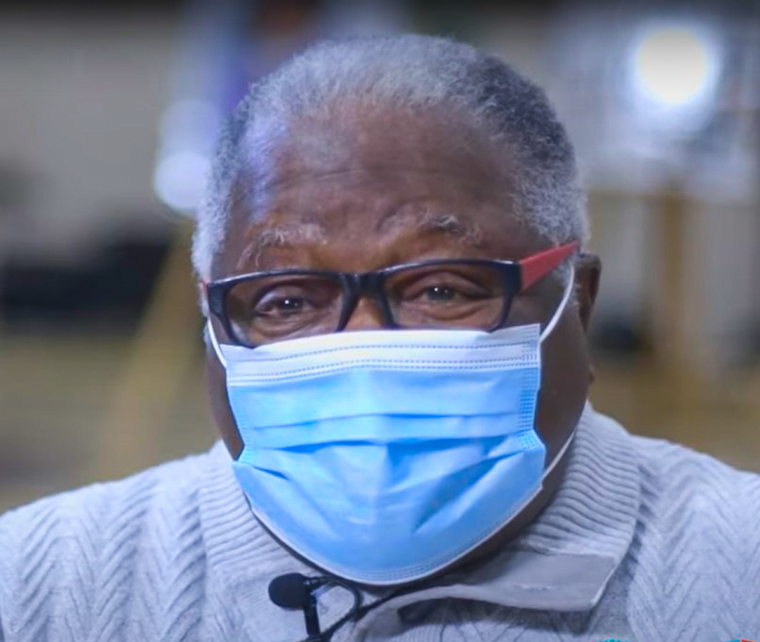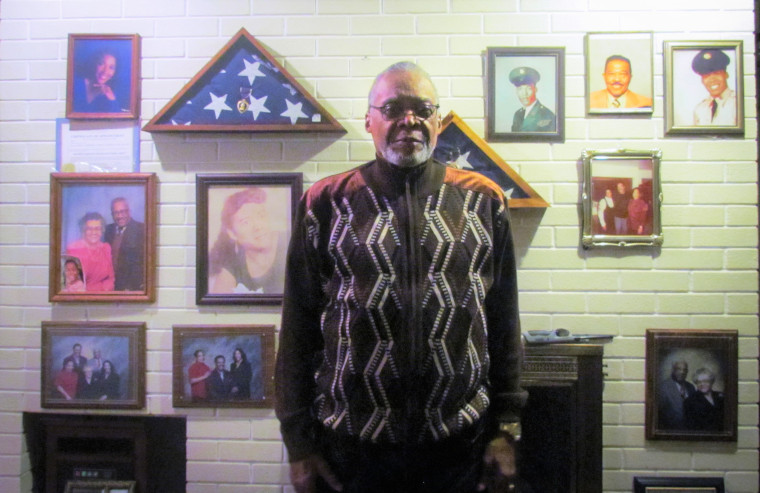Featured photo: James Wardlow, president of the St. John Street Historical Committee, stands by photos of his family members who grew up in the St. John Street neighborhood
Written by Tanya Terry
Members of the St. John Street Historical Committee have been working a long time trying to memorialize the racially diverse community where many Blacks thrived, known as the St. John Street Community.
The Michigan Department of Natural Resources recently announced recipients of its Michigan Spark Grants, awarding $1 million to the City of Flint for the development of the St. John Street Neighborhood Memorial Park. The park will be on the north side of Flint. James Wardlow, president of the St. John Street Historical Committee, told the Courier he is ecstatic about it.
The St. John Street Community is described as a “melting pot,” where people of many races were able to get along and enjoy each other. Although people who lived in the community remember the names of many of the businesses owned by people of other races, there were hundreds of Black-owned businesses.
The St. John Street Community’s northern boundary was two blocks north of Stewart Avenue. It was bounded on the south by Hamilton Avenue, on the east by the Flint River and on the west by Michigan Avenue. This was the area in which Blacks were allowed to live.
Genesee County Commissioner Charles Winfrey talked about how the St. John Street Community originally came into existence. This happened after the automobile industry began to take a foothold in the city.
People who came to work for the automobile industry lived in tents and built campgrounds near workplaces. Most of the encampment was around St. John Street at this time. That’s where people eventually began to build homes, schools and businesses.
“We were a Black mecca ‘cause basically everything on St. John Street was owned by Blacks…” recalled Jackie Poplar, a former Flint City Council member, in part two of the St. John Street Oral History Documentary.
The documentary was produced by Sloan Museum of Discovery in collaboration with the St. John Street Historical Committee. Wardlow said many individuals, such as Jerome Threlkheld were also instrumental in creating the documentary.

In part one of the documentary, members of the St. John Street Historical Committee shared about other good memories they have from the community. They reminisced about the games they played as children there and the places they enjoyed walking to or riding their bikes.
Arthur Bivins of the St. John Street Historical Committee pointed out community members could go downtown and leave all their windows and doors unlocked.
“We weren’t rich in money, but we were rich in culture,” said Wardlow. “Everyone looked out for everyone. Those less fortunate than others were taken care of.”
Wardlow talked to the Courier about how neighborhood residents who had gardens would share with other neighbors, for example.
Wardlow talks about how urban renewal was backed by most of the people of the St. John Street community because they misunderstood what was being told to them. He said those who had interest in the property played games with their words. Some St. John residents gave up their homes in exchange for money.
“But the whole initial idea was to wipe out that community and make it Industrial Park, as to what it is now for the GM suppliers,” said Wardlow.
The construction of I-475 also contributed to the community becoming scattered, which many consider a tragedy.

The St. John Street Neighborhood Historical Committee has helped create a development plan for the City St. John Street Neighborhood Memorial Park, envisioning a clean-up of the area, a safe and delightful place for children to play and much more.
This grant will support improved and accessible trails, repaving over 3.5 miles of the Flint River Trail, which runs through the park. Also funded through the grant will be a new playground, improvements to trail crossings at street intersections, repairs of seven existing scenic river overlooks and a new parking lot.
The City St. John Street Neighborhood Memorial Park is also supported by $250,000 from the City of Flint General Fund and $500,000 in City of Flint ARPA funds.
“Mayor Neeley, he has some family that grew up there in the St. John Street area. He associates with that. When we met with him initially he was very instrumental in getting the ball rolling.”
Although the families that were displaced from the St. John Street area were dispersed throughout the city, Wardlow feels the park will truly serve as a lasting monument to the St. John community. He expressed he feels the community is just one example of how Blacks can get along together and look out for each other.
To donate to the St. John Street Memorial Fund, click here: https://cfgf.iphiview.com/cfgf/OnlineDonation/tabid/542/dispatch/contribution_id$223281_hash$83e10a0920cf3a0324c5ec7b880c761688c69142/Default.aspx
Links to documentary:
Part 1: https://youtu.be/
Part 2: https://youtu.be/


